See also
- Ashfall Fossil Beds
- Gray Fossil Site
- List of fossil sites (with link directory)
- List of sinkholes of the United States
The Pipe Creek Sinkhole near Swayzee in Grant County, Indiana, is one of the most important paleontological sites in the interior of the eastern half of North America. It is preserved because it was buried by glacial till. [1] Uncovered in 1996 by workers at the Pipe Creek Junior limestone quarry, the sinkhole has yielded a diverse array of fossils from the Pliocene epoch, dating back five million years. Discoveries have been made there of the remains of camelids, bears, beavers, frogs, snakes, turtles, and several previously unknown species of rodents. Two fish taxa, bullhead ( Ameiurus ) and sunfish ( Centrarchidae ), have also been found there.
The Pipe Creek Sinkhole preserves an ancient wetland. It was created by the collapse of a limestone cave in a Silurian reef formation. That left a steep-sided depression about 75 meters (246 ft) long, 50 meters (164 ft) wide and 11 meters (36 ft) deep. When water collected in the depression, it became the habitat of the plants and animals whose remains were preserved there when the sinkhole was buried by glacial outwash and till during the Pleistocene Epoch, two million to 11,000 years ago.
While the ecology of the Pliocene in North America is well-known from fossil discoveries in other places, notably coastal sites, the Pleistocene glaciers destroyed or scattered most of the fossil remains in the continent's interior. The Pipe Creek Sinkhole, however, was buried by the glaciers and the debris they left, making it the only known Pliocene example in the central part of the eastern half of the continent.
The ancient wetland was home to a large and dense plant and animal population that includes both extinct and extant forms. The climate was warm and temperate, but somewhat dry, possibly supporting a grassland-forest transitional zone. The preserved vertebrate fauna are dominated by aquatic species, particularly leopard frogs, which are still common throughout the United States. Mammalian finds include an early rhinoceros ( Teleoceras , possibly from the Miocene epoch), canids, peccaries and short-faced bear.
Backed by a grant from the National Science Foundation, researchers from the Indiana State Museum and several universities substantially completed field work at the sinkhole in the summer of 2004, but there was about one weeklong dig a year from 2005 to 2011. [2] What probably was the last work at the site took place in 2014, with scientists and volunteers screening soil previously removed from the sinkhole.

The Gray Fossil Site is an Early Pliocene assemblage of fossils dating between 4.5 and 4.9 million years old, located near the town of Gray in Washington County, Tennessee. The site was discovered during road construction on Tennessee State Route 75 by the Tennessee Department of Transportation in May 2000, after which local officials decided to preserve the site for research and education. The site became part of East Tennessee State University, and the Gray Fossil Site & Museum was opened on the site in 2007.

Pseudhipparion is an extinct genus of three-toed horse endemic to North America during the Miocene. They were herding animals whose diet consisted of C3 plants. Fossils found in Georgia and Florida indicate that it was a lightweight horse, weighing up to 90 pounds. In 2005, fossils were unearthed in Oklahoma. Seven species of Pseudhipparion are known from the fossil record which were very small, following the trend of Bergmann's rule.

Cormohipparion is an extinct genus of horse belonging to the tribe Hipparionini that lived in North America during the late Miocene to Pliocene. This ancient species of horse grew up to 3 feet long.
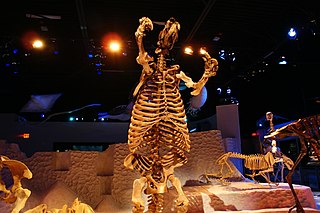
Thinobadistes is an extinct genus of ground sloth of the family Mylodontidae endemic to North America during the Miocene-Pliocene epochs (Hemphillian). It lived from 10.3 to 4.9 mya, existing for approximately 5.4 million years.
Plionarctos is an extinct genus of bear endemic to North America from the Miocene to the Pliocene, ~10.3—3.3 Mya, existing for about 7 million years.
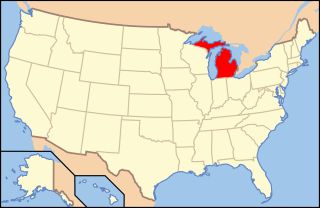
Paleontology in Michigan refers to paleontological research occurring within or conducted by people from the U.S. state of Michigan. During the Precambrian, the Upper Peninsula was home to filamentous algae. The remains it left behind are among the oldest known fossils in the world. During the early part of the Paleozoic Michigan was covered by a shallow tropical sea which was home to a rich invertebrate fauna including brachiopods, corals, crinoids, and trilobites. Primitive armored fishes and sharks were also present. Swamps covered the state during the Carboniferous. There are little to no sedimentary deposits in the state for an interval spanning from the Permian to the end of the Neogene. Deposition resumed as glaciers transformed the state's landscape during the Pleistocene. Michigan was home to large mammals like mammoths and mastodons at that time. The Holocene American mastodon, Mammut americanum, is the Michigan state fossil. The Petoskey stone, which is made of fossil coral, is the state stone of Michigan.

Paleontology in Indiana refers to paleontological research occurring within or conducted by people from the U.S. state of Indiana. Indiana's fossil record stretches all the way back to the Precambrian, when the state was inhabited by microbes. More complex organisms came to inhabit the state during the early Paleozoic era. At that time the state was covered by a warm shallow sea that would come to be inhabited by creatures like brachiopods, bryozoans, cephalopods, crinoids, and trilobites. During the Silurian period the state was home to significant reef systems. Indiana became a more terrestrial environment during the Carboniferous, as an expansive river system formed richly vegetated deltas where amphibians lived. There is a gap in the local rock record from the Permian through the Mesozoic. Likewise, little is known about the early to middle Cenozoic era. During the Ice Age however, the state was subject to glacial activity, and home to creatures like short-faced bears, camels, mammoths, and mastodons. After humans came to inhabit the state, Native Americans interpreted the fossil proboscidean remains preserved near Devil's Lake as the bones of water monsters. After the advent of formal scientific investigation one paleontological survey determined that the state was home to nearly 150 different kinds of prehistoric plants.

Paleontology in Illinois refers to paleontological research occurring within or conducted by people from the U.S. state of Illinois. Scientists have found that Illinois was covered by a sea during the Paleozoic Era. Over time this sea was inhabited by animals including brachiopods, clams, corals, crinoids, sea snails, sponges, and trilobites.
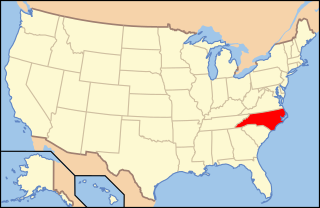
Paleontology in North Carolina refers to paleontological research occurring within or conducted by people from the U. S. state of North Carolina. Fossils are common in North Carolina. According to author Rufus Johnson, "almost every major river and creek east of Interstate 95 has exposures where fossils can be found". The fossil record of North Carolina spans from Eocambrian remains that are 600 million years old, to the Pleistocene 10,000 years ago.

Paleontology in Georgia refers to paleontological research occurring within or conducted by people from the U.S. state of Georgia. During the early part of the Paleozoic, Georgia was largely covered by seawater. Although no major Paleozoic discoveries have been uncovered in Georgia, the local fossil record documents a great diversity of ancient life in the state. Inhabitants of Georgia's early Paleozoic sea included corals, stromatolites, and trilobites. During the Carboniferous local sea levels dropped and a vast complex of richly vegetated delta formed in the state. These swampy deltas were home to early tetrapods which left behind footprints that would later fossilize. Little is known of Triassic Georgia and the Jurassic is absent altogether from the state's rock record. During the Cretaceous, however, southern Georgia was covered by a sea that was home to invertebrates and fishes. On land, the tree Araucaria grew, and dinosaurs inhabited the state. Southern Georgia remained submerged by shallow seawater into the ensuing Paleogene and Neogene periods of the Cenozoic era. These seas were home to small coral reefs and a variety of other marine invertebrates. By the Pleistocene the state was mostly dry land covered in forests and grasslands home to mammoths and giant ground sloths. Local coal mining activity has a history of serendipitous Carboniferous-aged fossil discoveries. Another major event in Georgian paleontology was a 1963 discovery of Pleistocene fossils in Bartow County. Shark teeth are the Georgia state fossil.

Paleontology in Wisconsin refers to paleontological research occurring within or conducted by people from the U.S. state of Wisconsin. The state has fossils from the Precambrian, much of the Paleozoic, some a parts of the Mesozoic and the later part of the Cenozoic. Most of the Paleozoic rocks are marine in origin. Because of the thick blanket of Pleistocene glacial sediment that covers the rock strata in most of the state, Wisconsin’s fossil record is relatively sparse. In spite of this, certain Wisconsin paleontological occurrences provide exceptional insights concerning the history and diversity of life on Earth.

Paleontology in Missouri refers to paleontological research occurring within or conducted by people from the U.S. state of Missouri. The geologic column of Missouri spans all of geologic history from the Precambrian to present with the exception of the Permian, Triassic, and Jurassic. Brachiopods are probably the most common fossils in Missouri.

Paleontology in Texas refers to paleontological research occurring within or conducted by people from the U.S. state of Texas. Author Marian Murray has said that "Texas is as big for fossils as it is for everything else." Some of the most important fossil finds in United States history have come from Texas. Fossils can be found throughout most of the state. The fossil record of Texas spans almost the entire geologic column from Precambrian to Pleistocene. Shark teeth are probably the state's most common fossil. During the early Paleozoic era Texas was covered by a sea that would later be home to creatures like brachiopods, cephalopods, graptolites, and trilobites. Little is known about the state's Devonian and early Carboniferous life. Evidence indicates that during the late Carboniferous the state was home to marine life, land plants and early reptiles. During the Permian, the seas largely shrank away, but nevertheless coral reefs formed in the state. The rest of Texas was a coastal plain inhabited by early relatives of mammals like Dimetrodon and Edaphosaurus. During the Triassic, a great river system formed in the state that was inhabited by crocodile-like phytosaurs. Little is known about Jurassic Texas, but there are fossil aquatic invertebrates of this age like ammonites in the state. During the Early Cretaceous local large sauropods and theropods left a great abundance of footprints. Later in the Cretaceous, the state was covered by the Western Interior Seaway and home to creatures like mosasaurs, plesiosaurs, and few icthyosaurs. Early Cenozoic Texas still contained areas covered in seawater where invertebrates and sharks lived. On land the state would come to be home to creatures like glyptodonts, mammoths, mastodons, saber-toothed cats, giant ground sloths, titanotheres, uintatheres, and dire wolves. Archaeological evidence suggests that local Native Americans knew about local fossils. Formally trained scientists were already investigating the state's fossils by the late 1800s. In 1938, a major dinosaur footprint find occurred near Glen Rose. Pleurocoelus was the Texas state dinosaur from 1997 to 2009, when it was replaced by Paluxysaurus jonesi after the Texan fossils once referred to the former species were reclassified to a new genus.
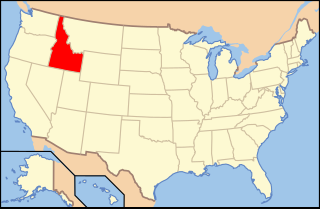
Paleontology in Idaho refers to paleontological research occurring within or conducted by people from the U.S. state of Idaho. The fossil record of Idaho spans much of the geologic column from the Precambrian onward. During the Precambrian, bacteria formed stromatolites while worms left behind trace fossils. The state was mostly covered by a shallow sea during the majority of the Paleozoic era. This sea became home to creatures like brachiopods, corals and trilobites. Idaho continued to be a largely marine environment through the Triassic and Jurassic periods of the Mesozoic era, when brachiopods, bryozoans, corals, ichthyosaurs and sharks inhabited the local waters. The eastern part of the state was dry land during the ensuing Cretaceous period when dinosaurs roamed the area and trees grew which would later form petrified wood.
Ochotona spanglei is an extinct species of pika, known from Late Miocene - Early Pliocene fossil from Oregon (USA). Fossils were also found in Nebraska referred to as Ochotona cf. spanglei.

The Bone Valley Formation is a geologic formation in Florida. It is sometimes classified as the upper member of the Peace River Formation of the Hawthorn Group. It contains economically important phosphorite deposits that are mined in west-central Florida, as well as rich assemblages of vertebrate fossils.
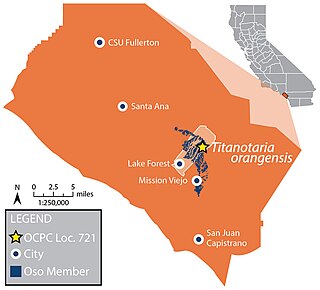
The Capistrano Formation is a geologic formation in coastal southern Orange County, California. It preserves fossils dating back to the late Miocene to early Pliocene, with the Oso Member representing a near-shore environment. Fifty-nine species and varieties of foraminifera are recognized from the Capistrano Formation alongside a diverse array of marine mammals including up to five species of walrus.
The Ocotillo Formation is a Pliocene fluvial-alluvial fan geologic formation in the Colorado Desert of Southern California.
The Juchipila Formation is a geologic formation in Mexico. It preserves fossils dating back to the Neogene period. Closely corresponding to the other Hemphillian faunal assemblages of North America, it is significant for understanding the palaeofauna of Miocene and Pliocene central Mexico.
The Gracias Formation is a geologic formation in Honduras. The mainly sandstones, siltstones and claystones preserve vertebrate fossils dating back to the Neogene period.